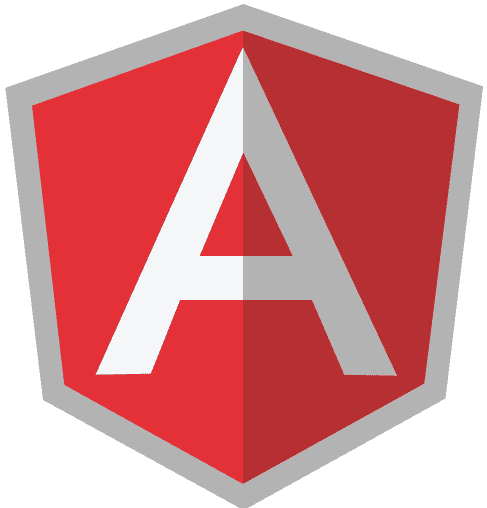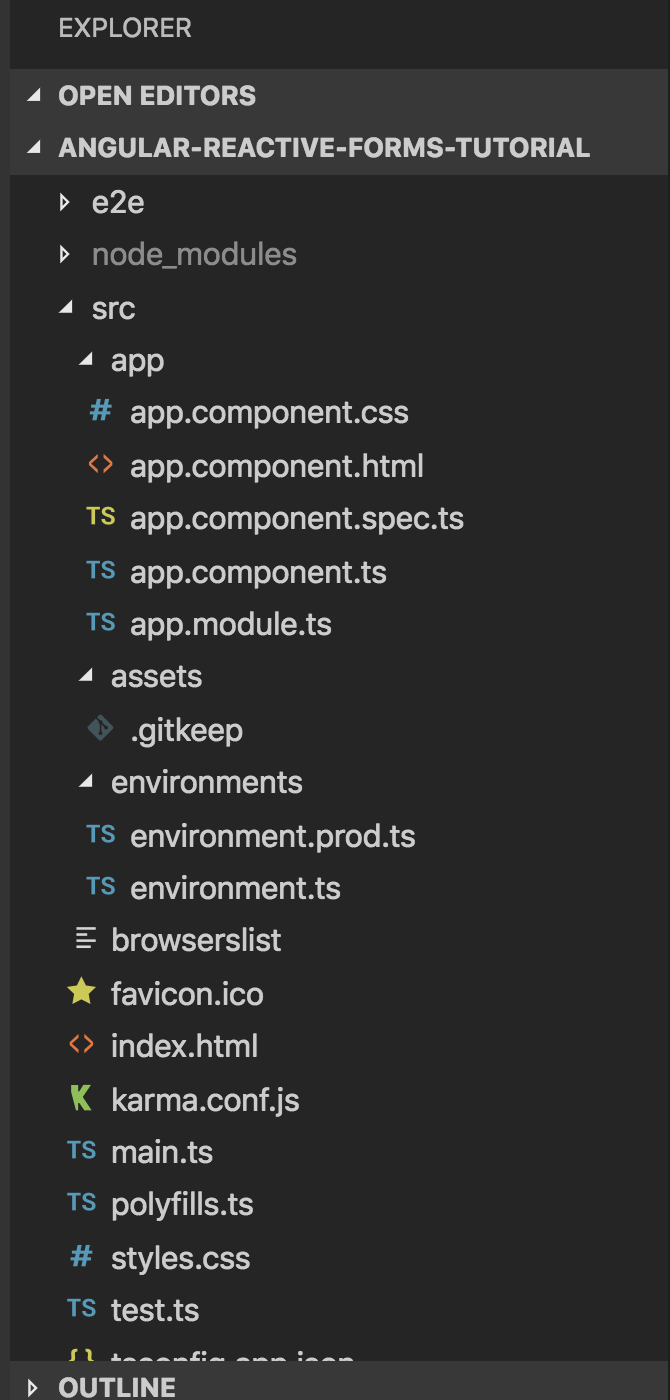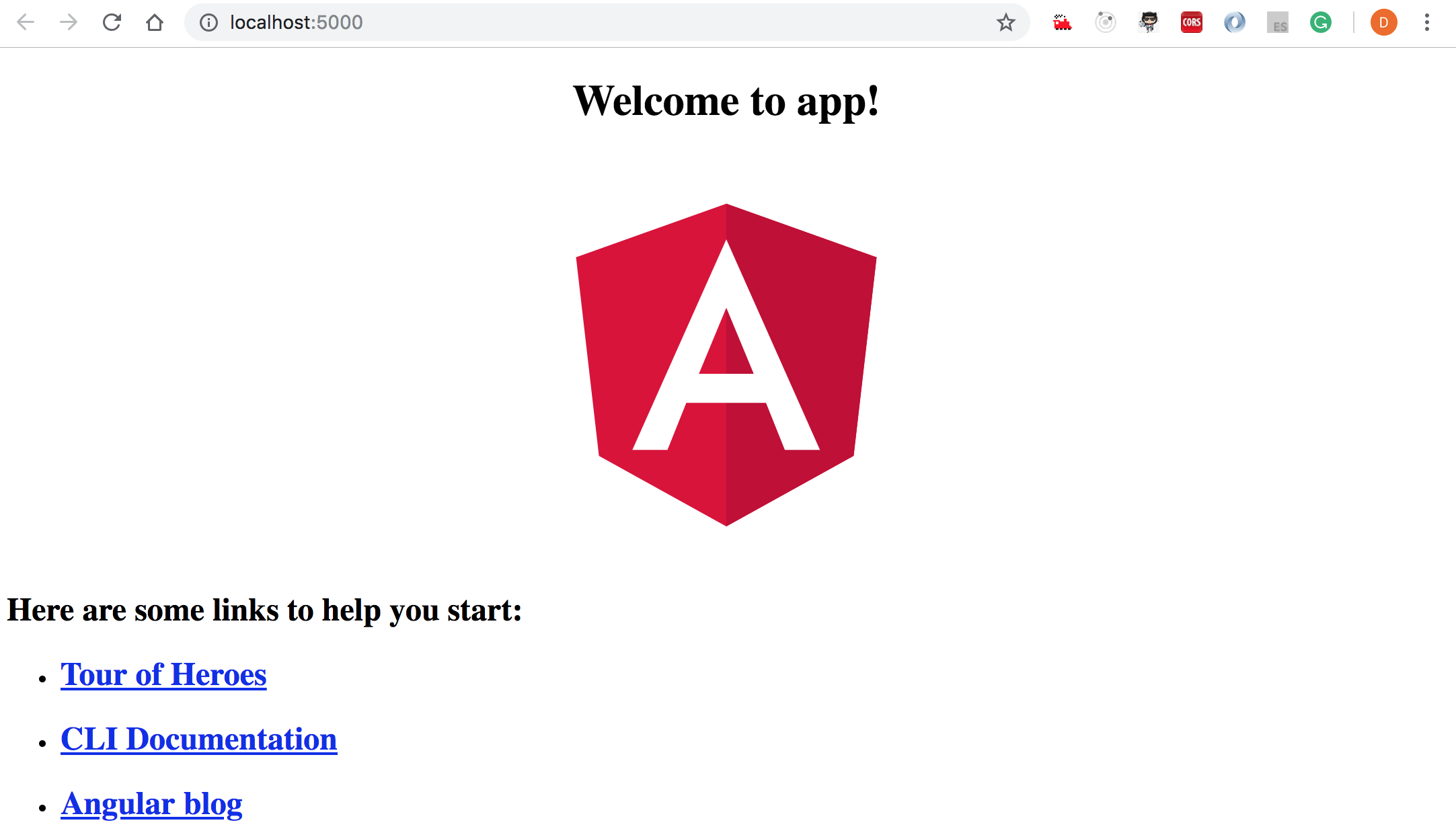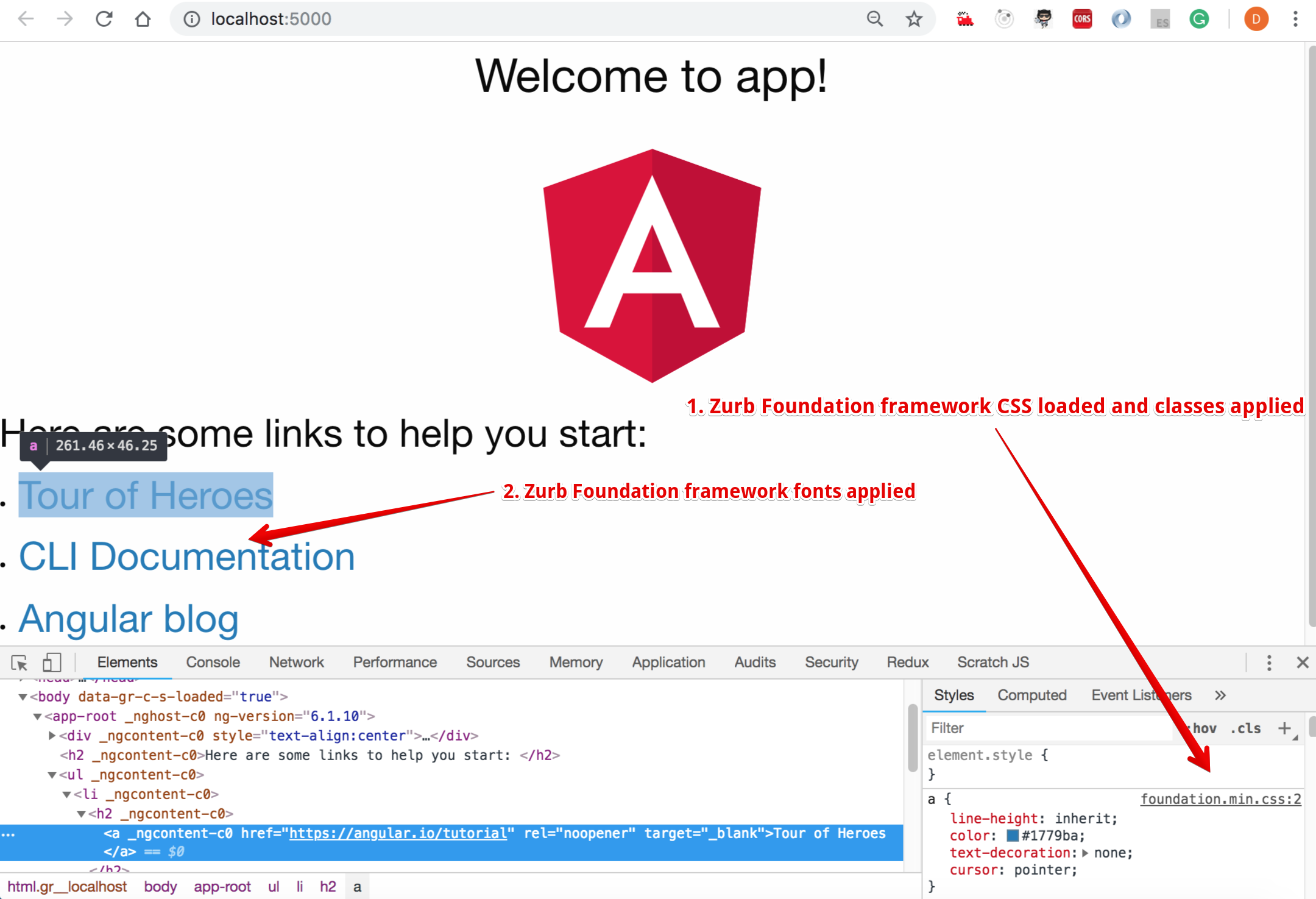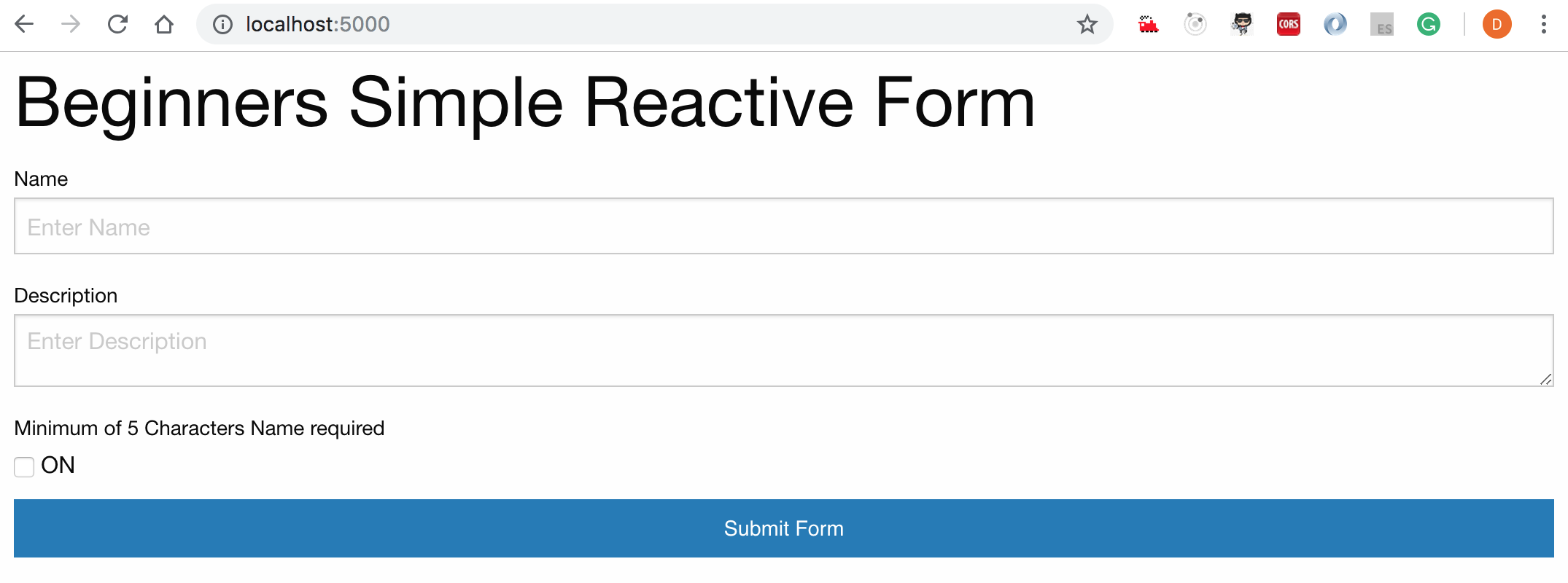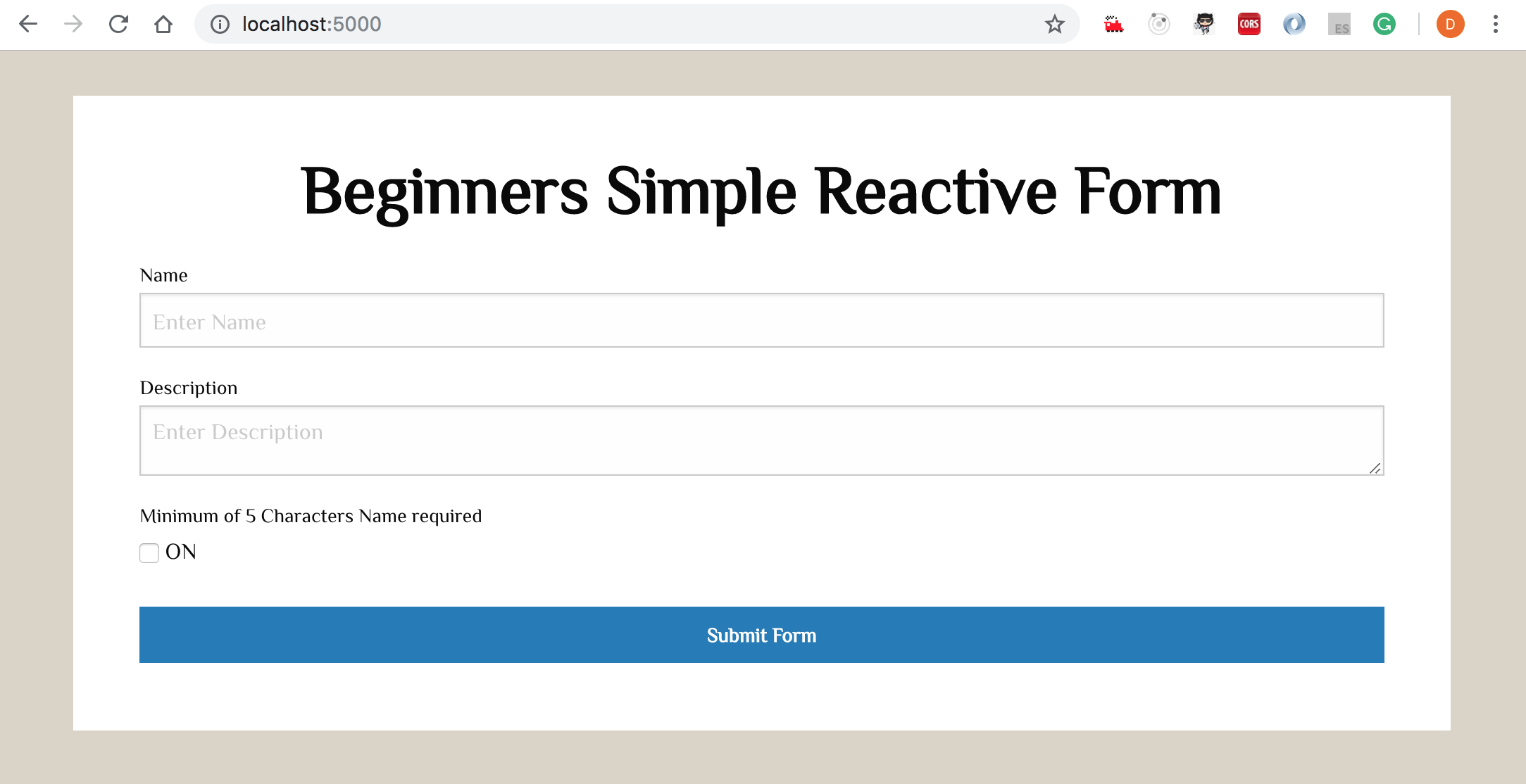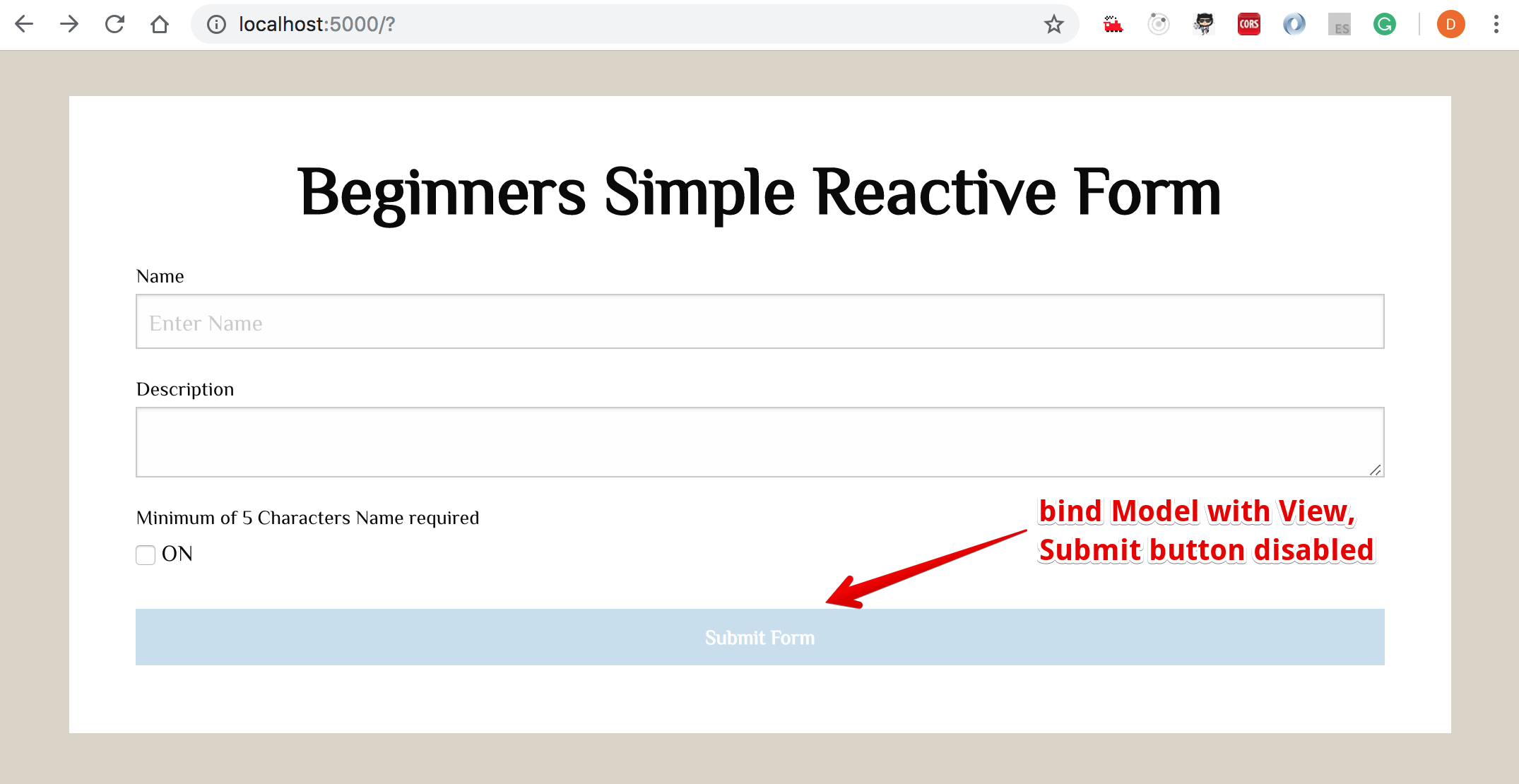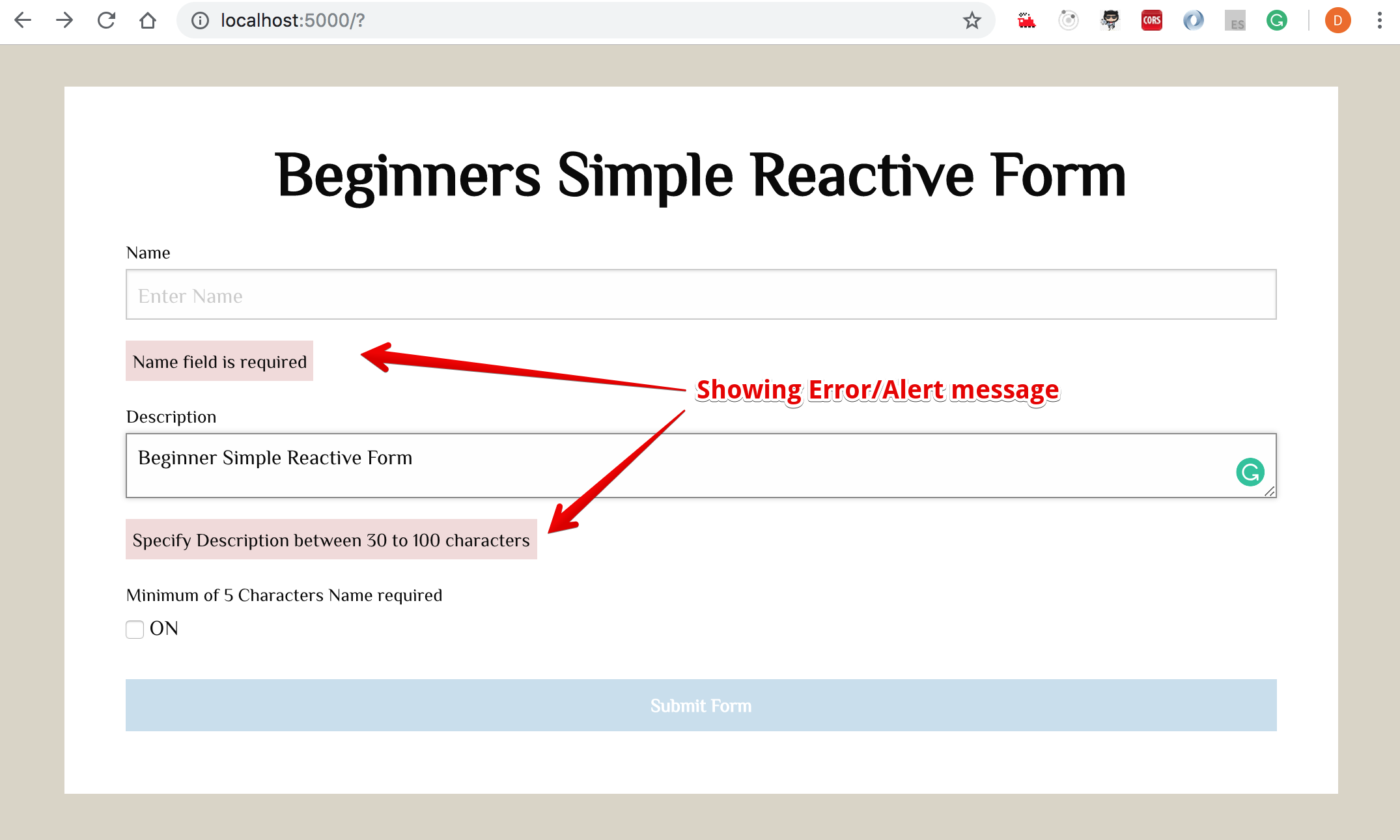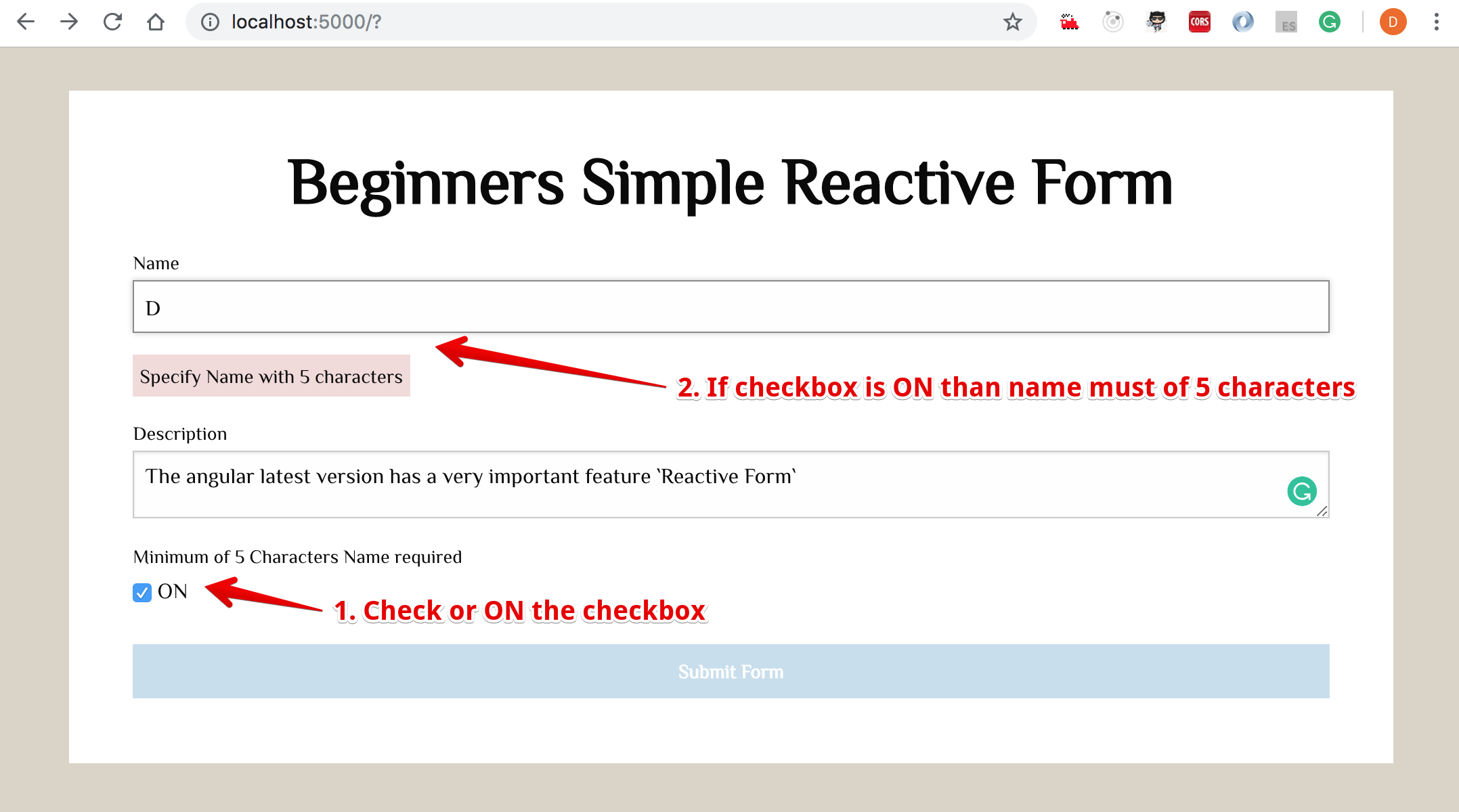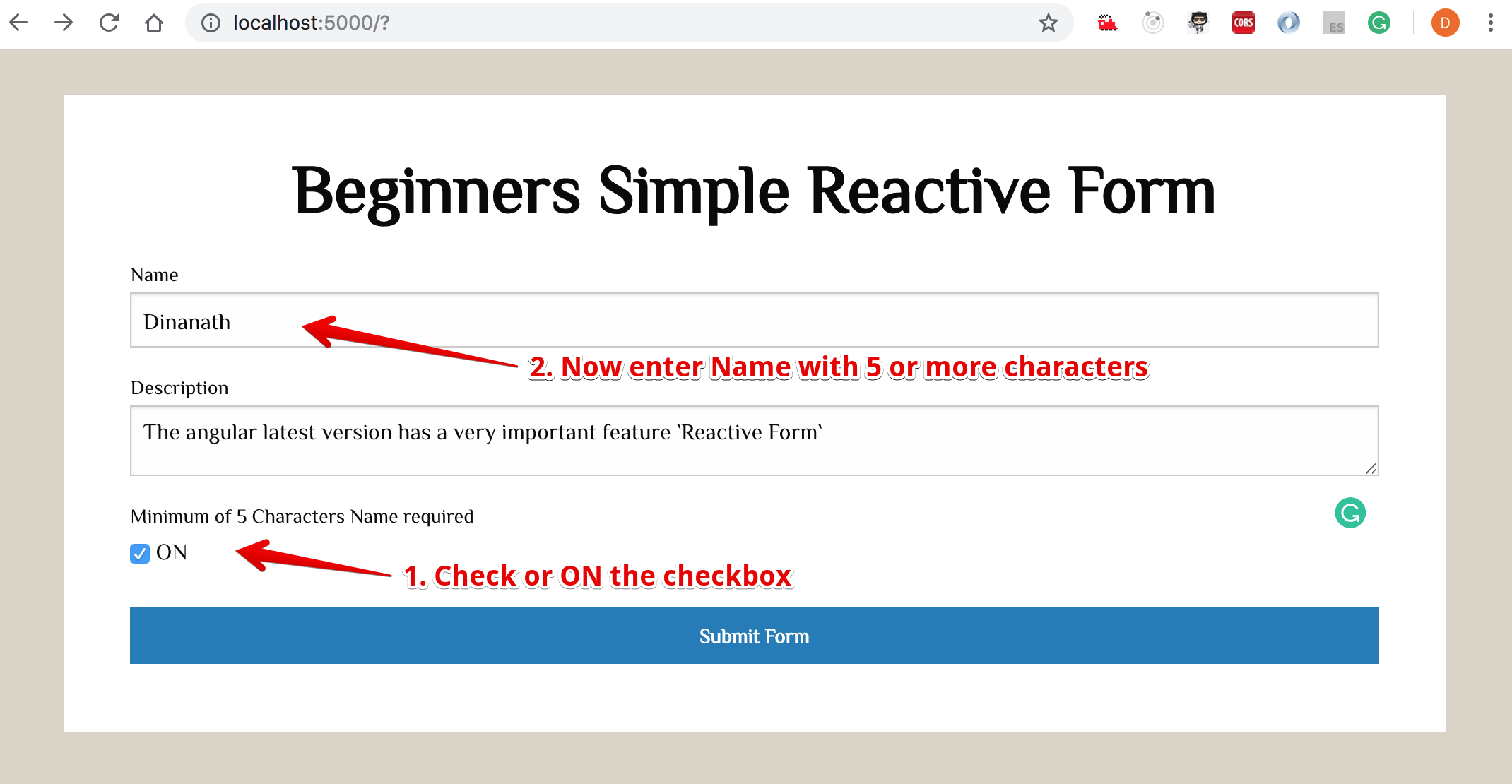- Clone or Download the project/app from Github or any other sources
- If using Visual Studio Code / Insiders, open Command panel/terminal from menu: View -> Terminal (shortcut key is
CTRL + BackTickORCOMMAND + J) - Go inside the project/app directory, command:
cd _examples-angular-templateDrivenForm OR cd templateDrivenForm - Run command:
npm installto install project/app dependencies(node_modules) - To Build and run Angular App, command:
ng serve / npm startORng serve -oORng serve --open - To change the port from 4200 to other port - type command:
ng serve --port 5000 - To check the application in browser type path/URL:
localhost:4200 / 5000
We know that:
- Reactive forms give the ability to control validation from the component code
- Also, we are able to do a unit test of reactive model-driven forms
- Create a
new Angular projectwith command at the console:ng new angular-reactive-forms-tutorial - Change Directory and get inside the directory with the command:
cd angular-reactive-forms-tutorialand check angular app folder structure
Image - Angular project/app folder structure
- Run/Serve/Build Angular application with the command:
ng serveorng serve -oorng serve --open-oor--openflag directly launch the application into default browser (default port is4200)- One can also change the port number by using the command:
ng serve --port 5000 -o
- Go to browser and type:
http://localhost:5000to launch an angular application
Image - Angular default app launch
- In
Index.htmlfile, inheadelement, link/import/include any front-end UI framework likeBootstraporZurb Foundationwhich helps to easily style our app/form layout
Syntax & Example: index.html
<link rel="stylesheet" href="https://cdnjs.cloudflare.com/ajax/libs/foundation/6.3.1/css/foundation.min.css">
or
<!-- link/import/include zurb foundation -->
<link rel="stylesheet" href="./assets/library/foundation.min.css">- To verify the Zurb Foundation included/working properly in an application,
check the angular app in browser fonts, etc changed?- Right click on page/element and check in
inspect elementthe Zurb Foundation classes and properties applied to respective elements:
- Right click on page/element and check in
Image - Zurb Foundation framework styly applied
- From file
app.component.htmldelete all old code and add new markup to create form:
Syntax & Example: app.component.html
<!-- show this template if name property not exist or form not submitted -->
<div *ngIf="!name; else formsubmitdata">
<form>
<div class="form-container">
<div class="row columns">
<h1>Beginners Simple Reactive Form</h1>
<!-- name -->
<label>Name
<input type="text" placeholder="Enter Name">
</label>
<!-- description -->
<label>Description
<textarea placeholder="Enter Description"></textarea>
</label>
<!-- checkbox -->
<label for="validate">Minimum of 5 Characters Name required</label>
<input type="checkbox" name="validate" value="1"> ON
<!-- submit button -->
<input type="submit" class="button expanded" value="Submit Form">
</div>
</div>
</form>
</div>
<!-- show this template if name property exists or form submitted -->
<ng-template #formsubmitdata>
<div class="form-container">
<div class="row columns">
<h1>You Entered Name: {{ name }}</h1>
<p>Your Description Details: {{ description }}</p>
</div>
</div>
</ng-template>Image - Simple HTML Form with Zurb Foundation
- With the
Zurb Foundation framework some styling applied, let us create some custom css style to make form/interface more attractive and intuative
Syntax & Example: styles.css
/* You can add global styles to this file, and also import other style files */
/* apply google font family */
@import url('https://fonts.googleapis.com/css?family=ZCOOL+XiaoWei');
body {
background:rgba(148, 134, 93, 0.35);;
/* font-family: 'ZCOOL XiaoWei', serif !important; */
}
* {
font-family: 'ZCOOL XiaoWei', serif !important;
}
.form-container {
display:block;
width:90%;
padding:2em;
margin: 2em auto;
background:#fff;
}
h1 {
text-align: center;
margin-bottom: 1rem;
font-weight:bold;
}
.button {
margin-top: 1rem;
font-weight: bold;
}
/* error text message alert */
.alert {
background: #f2dada;
padding: 5px;
font-size: .9em;
margin-bottom: 15px;
display: inline-block;
animation: 2s alertAnim forwards;
}
/* animation effect for error text message alert */
@keyframes alertAnim {
from {
opacity:0;
transform: translateY(-20px);
}
to {
opacity:1;
transform: translateY(0);
}
}Image - CSS Style applied HTML Form
- To work with reactive/dynamic forms we need to import
'ReactiveFormsModule'which provides bunch of classes/directives/utilities necessary to build reactive/dynamic forms
- In
app.module.ts: import { ReactiveFormsModule } from '@angular/forms';- also add to imports: [ ReactiveFormsModule ]
Syntax & Example: app.module.ts
import { BrowserModule } from '@angular/platform-browser';
import { NgModule } from '@angular/core';
import { AppComponent } from './app.component';
import { ReactiveFormsModule } from '@angular/forms';
@NgModule({
declarations: [
AppComponent
],
imports: [
BrowserModule,
ReactiveFormsModule
],
providers: [],
bootstrap: [AppComponent]
})
export class AppModule { }FormGroupandFormControlare two important building blocks classes for reactive/dynamic forms- In Reactive forms, the form is represented by
model in component class, FormGroup and FormControl classes used to make that model FormGrouprepresents whole/entire form (formis instance ofFormGroupclass )FormControlrepresents each form field (form fieldsare instance ofFormControlclass )FormBuilderhandle form control creation, dynamic/run time field/FormControl creationValidatorshelps to setup validation on each form control
- In Reactive forms, the form is represented by
- In
app.component.tsimport { FormBuilder, FormGroup, Validators } from '@angular/forms'; and write following logical code to build reactive form
Syntax & Example: app.component.ts
import { Component } from '@angular/core';
import { FormBuilder, FormGroup, Validators } from '@angular/forms';
@Component({
selector: 'app-root',
templateUrl: './app.component.html',
styleUrls: ['./app.component.css']
})
export class AppComponent {
simpleBegReactiveForm: FormGroup; // form
formSubmitPost: any; // A property for our submitted form
name: string = ''; // name text
description: string = ''; // description text
// create a FormBuilder dependecy injection
constructor(private fb: FormBuilder) {
// reference FormBuilder instance to control the validation of each form field
this.simpleBegReactiveForm = fb.group({
'name': ['', Validators.required],
'description': ['', [Validators.required, Validators.minLength(30), Validators.maxLength(100)]],
'validate': ''
});
}
// handler to submit form
submitFormData(formSubmitPost) {
this.description = formSubmitPost.description;
this.name = formSubmitPost.name;
}
}- Lets use and apply class members created in
app.component.tsfor specific field/controls and bind with form and input fields,([formGroup]="simpleBegReactiveForm", formControlName="name" ...)
Syntax & Example: app.component.html
<!-- show this template if name property not exist or form not submitted -->
<div *ngIf="!name; else formsubmitdata">
<!-- associate the model with view -->
<form [formGroup]="simpleBegReactiveForm" (ngSubmit)="submitFormData(simpleBegReactiveForm.value)">
<div class="form-container">
<div class="row columns">
<h1>Beginners Simple Reactive Form</h1>
<!-- name -->
<label>Name
<input type="text" placeholder="Enter Name" formControlName="name">
</label>
<!-- description -->
<label>Description
<textarea formControlName="description"></textarea>
</label>
<!-- checkbox -->
<label for="validate">Minimum of 5 Characters Name required</label>
<input type="checkbox" name="validate" value="1" formControlName="validate" > ON
<!-- submit button -->
<input type="submit" class="button expanded" value="Submit Form" [disabled]="!simpleBegReactiveForm.valid">
</div>
</div>
</form>
</div>Image - Bind Model with View
- Now add required validation message text as a alert and use interpolation to show class member
Syntax & Example: app.component.html
<!-- show name alert text -->
<div class="alert" *ngIf="!simpleBegReactiveForm.controls['name'].valid && simpleBegReactiveForm.controls['name'].touched">{{ titleAlertText }}</div>
<!-- show name description text -->
<div class="alert" *ngIf="!simpleBegReactiveForm.controls['description'].valid && simpleBegReactiveForm.controls['description'].touched">{{ descriptionAlertText }}</div>Syntax & Example: app.component.ts
titleAlertText = 'Name field is required';
descriptionAlertText = 'Specify Description between 30 to 100 characters';Image - Shwoing alert error message text
- Sometimes we need to perform form validation based on user input
- Like in current form, If checkbox is
ONthanName must required with 5 characterselseany characters - We need to track value of checkbox and conditionaly set status of other field
valueChangesproperty helps to track the current value of any controls as a observablessetValidatorsmethods - set desired validators to formControl/fieldclearValidatorsmethods - clears validators from formControl/field
- Finally we need to invoke/call
updateValueAndValiditymethod to reflect latest status
Syntax & Example: app.component.ts
ngOnInit() {
// subscribe checkbox
this.simpleBegReactiveForm.get('validate').valueChanges.subscribe(
(validate) => {
if (validate == '1') {
// name field set/unset `required` validators
this.simpleBegReactiveForm.get('name').setValidators([Validators.required, Validators.minLength(5)]);
this.titleAlertText = 'Specify Name with 5 characters';
} else {
this.simpleBegReactiveForm.get('name').setValidators(Validators.required);
this.titleAlertText = 'Name field is required';
}
// to reflect latest correct status
this.simpleBegReactiveForm.get('name').updateValueAndValidity();
});
}Image - Checkbox dynamic validator error
Image - Checkbox dynamic validator success
Image - Submit Data success screen
Syntax & Example: index.html
<!doctype html>
<html lang="en">
<head>
<meta charset="utf-8">
<title>AngularReactiveFormsTutorial</title>
<base href="/">
<meta name="viewport" content="width=device-width, initial-scale=1">
<link rel="icon" type="image/x-icon" href="favicon.ico">
<!-- link/import/include zurb foundation -->
<link rel="stylesheet" href="./assets/library/foundation.min.css">
</head>
<body>
<app-root></app-root>
</body>
</html>Syntax & Example: app.component.html
<!-- show this template if name property not exist or form not submitted -->
<div *ngIf="!name; else formsubmitdata">
<!-- associate the model with view -->
<form [formGroup]="simpleBegReactiveForm" (ngSubmit)="submitFormData(simpleBegReactiveForm.value)">
<div class="form-container">
<div class="row columns">
<h1>Beginners Simple Reactive Form</h1>
<!-- name -->
<label>Name
<input type="text" placeholder="Enter Name" formControlName="name">
</label>
<!-- show name alert text -->
<div class="alert" *ngIf="!simpleBegReactiveForm.controls['name'].valid && simpleBegReactiveForm.controls['name'].touched">{{ titleAlertText }}</div>
<!-- description -->
<label>Description
<textarea formControlName="description"></textarea>
</label>
<!-- show name description text -->
<div class="alert" *ngIf="!simpleBegReactiveForm.controls['description'].valid && simpleBegReactiveForm.controls['description'].touched">{{ descriptionAlertText }}</div>
<!-- checkbox -->
<label for="validate">Minimum of 5 Characters Name required</label>
<input type="checkbox" name="validate" value="1" formControlName="validate" > ON
<!-- submit button -->
<input type="submit" class="button expanded" value="Submit Form" [disabled]="!simpleBegReactiveForm.valid">
</div>
</div>
</form>
</div>
<!-- show this template if name property exists or form submitted -->
<ng-template #formsubmitdata>
<div class="form-container">
<div class="row columns">
<h2>You Entered Name: {{ name }}</h2>
<p>Your Description Details: {{ description }}</p>
</div>
</div>
</ng-template>Syntax & Example: styles.css
/* You can add global styles to this file, and also import other style files */
/* apply google font family */
@import url('https://fonts.googleapis.com/css?family=ZCOOL+XiaoWei');
body {
background:rgba(148, 134, 93, 0.35);;
/* font-family: 'ZCOOL XiaoWei', serif !important; */
}
* {
font-family: 'ZCOOL XiaoWei', serif !important;
}
.form-container {
display:block;
width:90%;
padding:2em;
margin: 2em auto;
background:#fff;
}
h1 {
text-align: center;
margin-bottom: 1rem;
font-weight:bold;
}
.button {
margin-top: 1rem;
font-weight: bold;
}
/* error text message alert */
.alert {
background: #f2dada;
padding: 5px;
font-size: .9em;
margin-bottom: 15px;
display: inline-block;
animation: 2s alertAnim forwards;
}
/* animation effect for error text message alert */
@keyframes alertAnim {
from {
opacity:0;
transform: translateY(-20px);
}
to {
opacity:1;
transform: translateY(0);
}
}Syntax & Example: app.module.ts
import { BrowserModule } from '@angular/platform-browser';
import { NgModule } from '@angular/core';
import { AppComponent } from './app.component';
import { ReactiveFormsModule } from '@angular/forms';
@NgModule({
declarations: [
AppComponent
],
imports: [
BrowserModule,
ReactiveFormsModule
],
providers: [],
bootstrap: [AppComponent]
})
export class AppModule { }Syntax & Example: app.component.ts
import { Component } from '@angular/core';
import { FormBuilder, FormGroup, Validators } from '@angular/forms';
@Component({
selector: 'app-root',
templateUrl: './app.component.html',
styleUrls: ['./app.component.css']
})
export class AppComponent {
simpleBegReactiveForm: FormGroup; // form
formSubmitPost: any; // A property for our submitted form
name: string = ''; // name text
description: string = ''; // description text
titleAlertText = 'Name field is required';
descriptionAlertText = 'Specify Description between 30 to 100 characters';
// create a FormBuilder dependecy injection
constructor(private fb: FormBuilder) {
// reference FormBuilder instance to control the validation of each form field
this.simpleBegReactiveForm = fb.group({
'name': ['', Validators.required],
'description': ['', [Validators.required, Validators.minLength(30), Validators.maxLength(100)]],
'validate': ''
});
}
// handler to submit form
submitFormData(formSubmitPost) {
this.description = formSubmitPost.description;
this.name = formSubmitPost.name;
}
ngOnInit() {
// subscribe checkbox
this.simpleBegReactiveForm.get('validate').valueChanges.subscribe(
(validate) => {
if (validate == '1') {
// name field set/unset `required` validators
this.simpleBegReactiveForm.get('name').setValidators([Validators.required, Validators.minLength(5)]);
this.titleAlertText = 'Specify Name with 5 characters';
} else {
this.simpleBegReactiveForm.get('name').setValidators(Validators.required);
this.titleAlertText = 'Specify Name with 5 characters';
}
// to reflect latest correct status
this.simpleBegReactiveForm.get('name').updateValueAndValidity();
});
}
}